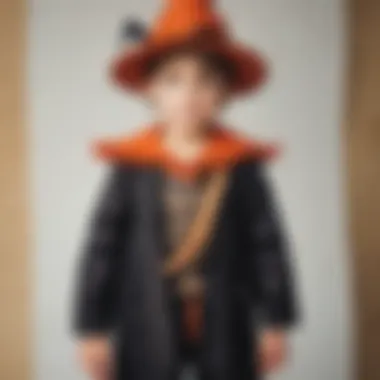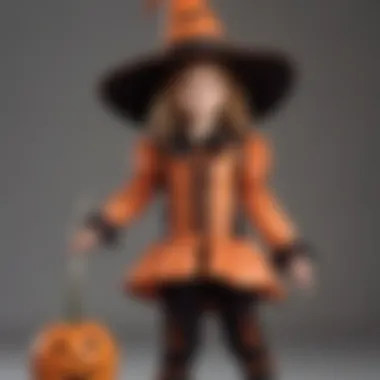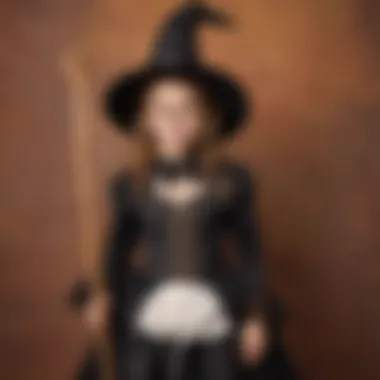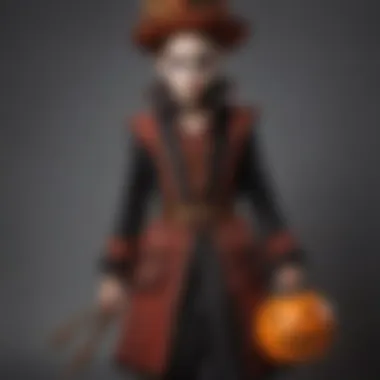Unleash Your Creativity: Homemade Halloween Costumes for Kids


Fun Activities Ideas
Are you ready to dive into a world of Halloween creativity with your child this year? Let's explore a range of spooky, whimsical, and utterly unique DIY Halloween costume ideas that will guarantee your little one stands out on that fateful night. From crafting magical creatures to eerie beings, this guide will walk you through the process of creating homemade Halloween costumes that are bound to impress!
- Indoor Activities: Engage in indoor DIY costume-making sessions, where you and your child can let your imagination run wild with fabrics, accessories, and face paints to bring your costume vision to life. Whether it's a mystical unicorn or a menacing vampire, the possibilities are endless.
- Outdoor Adventures: Take the Halloween spirit outdoors by sourcing natural materials like leaves, twigs, and flowers to add an extra element of creativity to your costumes. Think woodland fairies, enchanted wizards, or even spooky haunted forest creatures.
- Arts and Crafts: Embrace the arts and crafts realm by incorporating elements like paper maché, fabric scraps, and recyclable materials into your costume designs. Transform cardboard boxes into medieval castles or create wings for a majestic dragon - the artistry is in your hands!
- Science Experiments: Delve into the science behind costume-making by experimenting with glow-in-the-dark paints, color-changing fabrics, or even concocting special effects like bubbling potions or smoking cauldrons for a truly unique Halloween experience.
- Cooking and Baking: Get culinary with your costume creations by using food-grade materials like gelatin for prosthetic wounds, edible glitter for fairy dust accents, or even baking your own themed cookies for a deliciously spooky touch.
Introduction to Homemade Halloween Costumes
In the realm of Halloween festivities, the creation of homemade costumes holds a special significance that resonates with both children and parents alike. This article serves as a comprehensive guide for creative parents, outlining the intricacies of crafting unique Halloween attire. Homemade costumes not only embody a spirit of innovation and individuality but also foster a collaborative environment where families can bond over creative projects. The charm of homemade Halloween costumes lies in their ability to transcend store-bought options, allowing for a personalized touch that captures the essence of each child's imagination.
Significance of Homemade Costumes
Encouraging Creativity
Encouraging creativity is a fundamental aspect of crafting homemade Halloween costumes. By embarking on the journey of designing and assembling a costume from scratch, children are encouraged to think outside the box and explore their artistic abilities. This creative process instills a sense of ownership and pride in the final product, nurturing a child's confidence and innovative spirit. Homemade costumes not only stimulate imagination but also provide a platform for self-expression, fostering a deep connection between the child and their costume.
Personalized Touch
The personalized touch offered by homemade costumes sets them apart from mass-produced alternatives. Tailoring a costume to align with a child's unique interests, favorite characters, or imaginative ideas creates a one-of-a-kind ensemble that reflects their individuality. This personalization aspect allows both parents and children to collaborate on design choices, creating a bond and shared experience during the costume-making process. The personalized touch of homemade costumes extends beyond appearances, encapsulating memories and sentiments that are woven into the fabric of the costume itself.
Budget-Friendly Option
Opting for homemade Halloween costumes presents a budget-friendly alternative to purchasing pre-made outfits. With the flexibility to reuse household items, repurpose clothing, and utilize craft supplies, DIY costumes offer a cost-effective solution for families. This budget-friendly approach not only saves money but also encourages resourcefulness and creativity, as parents and children brainstorm innovative ways to bring their costume ideas to life without breaking the bank. Homemade costumes embody a blend of thriftiness and creativity, proving that extravagant spending is not a prerequisite for a standout Halloween look.
Ideas for DIY Halloween Costumes
In the realm of creating homemade Halloween costumes, generating unique and innovative ideas is paramount. The section on Ideas for DIY Halloween Costumes serves as a creative springboard for parents looking to elevate their costume-making skills and leave a lasting impression on Halloween night. By exploring a diverse range of costume concepts, parents can engage in a fulfilling and imaginative process that allows them to tailor costumes to their children's preferences and interests. These ideas not only spark creativity but also enable parents to bond with their children through collaborative costume planning, resulting in memorable and cherished experiences.
Classic Costumes with Homemade Twist
Witch or Wizard
The Witch or Wizard costume holds a special place in the realm of Halloween costumes due to its mystique and whimsical charm. By infusing a homemade twist into this classic costume, parents can personalize the design to reflect their child's unique personality and style. The key characteristic of the Witch or Wizard costume lies in its versatility, allowing for intricate details and accessories that enhance its magical allure. This costume choice is beneficial for parents seeking a timeless yet enchanting ensemble for their child, fostering a sense of wonder and delight on Halloween night. While the elaborateness of creating a Witch or Wizard costume may pose challenges in terms of complexity, the overall outcome promises a visually stunning and captivating appearance that showcases the parent's dedication to craftsmanship and creativity.
Ghost
The Ghost costume offers a blend of simplicity and spookiness, making it a popular choice for DIY Halloween costumes. Its key characteristic lies in its ethereal and haunting aesthetic, creating an otherworldly presence that resonates well with the Halloween spirit. Despite its simplicity, the Ghost costume allows room for creative interpretation, enabling parents to experiment with various fabric textures and embellishments to enhance its ghostly appeal. One unique feature of the Ghost costume is its adaptability to different age groups and preferences, making it a versatile option for parents looking to craft a costume that is both eerie and evocative. While the Ghost costume is relatively easy to assemble compared to more elaborate designs, its impact relies heavily on the execution of subtle details and theatrical flair to achieve a convincing and ghostly effect.
Pirate
The Pirate costume embodies a sense of adventure and swashbuckling charm, making it a timeless and classic choice for DIY Halloween costumes. With its detailed accessories and rugged appeal, the Pirate costume appeals to children's imaginations and adventurous spirits. The key characteristic of the Pirate costume lies in its bold and rugged aesthetic, featuring elements such as eye patches, swords, and tricorn hats that evoke a sense of mystery and seafaring lore. This costume choice is popular among children for its theatrical flair and ability to transform them into daring buccaneers ready to set sail on Halloween night. While creating a Pirate costume may involve more intricate crafting techniques, the overall outcome exudes a sense of creativity and craftsmanship that allows parents to showcase their attention to detail and flair for imaginative design.
Unique and Creative Costume Concepts
Space Explorer


The Space Explorer costume offers a futuristic and imaginative twist on traditional Halloween attire, catering to children fascinated by outer space and galactic adventures. Its key characteristic lies in its sleek and futuristic aesthetic, incorporating elements such as metallic fabrics, space helmets, and celestial motifs that transport children to far-off galaxies. This costume choice is beneficial for parents seeking to foster a love for science and exploration in their children, encouraging them to embrace curiosity and wonder about the cosmos. One unique feature of the Space Explorer costume is its potential for customization and futuristic accents, allowing parents to experiment with innovative materials and embellishments to create a truly out-of-this-world ensemble. While the Space Explorer costume may pose challenges in terms of sourcing specialized materials, the final result promises a visually striking and thought-provoking appearance that resonates with both children and adults alike.
Medieval Knight
The Medieval Knight costume harkens back to an era of chivalry and noble valor, offering children the chance to embody courageous knights of old in their quest for Halloween treats. Its key characteristic lies in its regal and armor-clad aesthetic, featuring chainmail, tabards, and helmets that evoke images of medieval splendor and gallantry. This costume choice is popular for its historical charm and storytelling potential, enabling children to engage in imaginative role-play as brave knights defending their kingdom. One unique feature of the Medieval Knight costume is its attention to detail and craftsmanship, with intricate armor pieces and heraldic emblems adding an air of authenticity to the ensemble. While creating a Medieval Knight costume may require precision and planning to capture its medieval essence, the end result is a majestic and awe-inspiring costume that transports children to a bygone era of knights and legends.
Steampunk Inventor
The Steampunk Inventor costume blends Victorian aesthetics with retro-futuristic elements, offering a creative and inventive twist on traditional Halloween attire. Its key characteristic lies in its fusion of Victorian fashion and steam-powered gadgets, creating a visually engaging ensemble that appeals to children with a passion for science fiction and innovation. This costume choice is beneficial for parents looking to encourage their children's creativity and ingenuity, as the Steampunk theme invites experimentation with machinery, gears, and goggles to achieve a distinctive look. One unique feature of the Steampunk Inventor costume is its emphasis on DIY craftsmanship and upcycling, as parents can repurpose everyday items into imaginative steampunk accessories that add character and depth to the costume. While crafting a Steampunk Inventor ensemble may involve unconventional materials and construction techniques, the final outcome exudes a sense of whimsy and inventiveness that showcases a unique blend of vintage charm and futuristic flair.
Step-by-Step Costume Crafting Guides
In the realm of creating homemade Halloween costumes for children, the step-by-step costume crafting guides play a pivotal role in ensuring the successful execution of these DIY projects. These guides serve as a roadmap for creative parents, assisting them in navigating the intricate process of costume creation with precision and efficiency. By breaking down the costume crafting journey into manageable steps, these guides empower parents to embark on this creative endeavor with confidence and clarity.
Creating Costume Patterns
Designing Templates
Designing templates is a fundamental aspect of costume crafting, offering a structured approach to creating custom-fit costumes. The key characteristic of designing templates lies in its ability to serve as a blueprint for the costume, allowing parents to visualize the final product before embarking on the construction phase. This method not only ensures accurate measurements but also enables parents to tailor the costume to suit their child's preferences. The unique feature of designing templates lies in its versatility, as it caters to a wide range of costume designs, from elaborate ensembles to simple attire.
Measuring and Cutting
Measuring and cutting are essential components of costume crafting, emphasizing precision and attention to detail. The key characteristic of this step is its focus on translating design concepts into physical form, requiring meticulous measurements and skillful cutting techniques. This process ensures that each component of the costume is tailored to fit perfectly, enhancing comfort and aesthetics. Despite its time-consuming nature, measuring and cutting are indispensable steps that lay the foundation for a well-crafted costume.
Assembling Components
Assembling components involves bringing together the various elements of the costume to create a cohesive ensemble. The key characteristic of this phase is its hands-on approach, where parents use their crafting skills to construct the costume piece by piece. This step requires precision and patience, as each component must be aligned correctly to achieve the desired outcome. The uniqueness of assembling components lies in the sense of accomplishment it brings, as parents witness their vision come to life through the creative arrangement of materials.
Adding Details and Embellishments
Decorative Stitching
Decorative stitching adds a touch of flair to homemade costumes, elevating them from simple ensembles to intricate works of art. The key characteristic of decorative stitching is its ability to enhance the aesthetic appeal of the costume, providing texture and visual interest. This technique allows parents to infuse their creations with personality and character, making each costume unique. While time-consuming, decorative stitching is a rewarding process that adds value to the final costume design.
Accessory Attachments
Accessory attachments are the final touches that complete the costume, adding functionality and charm. The key characteristic of accessory attachments lies in their ability to enhance the overall look of the costume, complementing the theme and design. From prop weapons to jewelry, these additions contribute to the authenticity of the costume, capturing the essence of the character being portrayed. While optional, accessory attachments play a significant role in elevating the costume to a professional level.
Painting and Coloring
Painting and coloring offer a creative outlet for parents to imbue their costumes with color and vibrancy. The key characteristic of painting and coloring is their capacity to transform plain fabric into a colorful canvas, allowing for artistic expression. This process enables parents to customize their costumes to match specific themes or characters, adding depth and dimension. While messy at times, painting and coloring breathe life into the costume, turning it into a wearable masterpiece.
Final Touches and Finishing
Fit Adjustment
Fit adjustment ensures that the costume fits comfortably and snugly, catering to the child's movements and activities. The key characteristic of fit adjustment is its emphasis on tailoring the costume to the child's body shape, preventing discomfort and restrictions. This step allows parents to make necessary alterations to enhance the overall fit, enhancing the costume's functionality. While requiring precision, fit adjustment guarantees that the costume not only looks good but also feels good on the wearer.


Quality Check
Quality check is a crucial step that ensures the craftsmanship and durability of the costume meet expectations. The key characteristic of quality check is its meticulous attention to detail, where parents inspect every seam and embellishment for flaws. This process guarantees that the costume is of high quality and will withstand the wear and tear of festivities. While time-intensive, quality check is essential to achieving a professional-grade costume that both parents and children can be proud of.
Photography Tips
Photography tips offer guidance on capturing the essence of the costume through engaging and visually appealing images. The key characteristic of photography tips is their ability to showcase the costume in its full glory, highlighting intricate details and design elements. This step ensures that all the hard work put into creating the costume is recorded for posterity, serving as a lasting memory. By exploring different angles and lighting techniques, parents can immortalize their child's homemade costume in captivating photographs, preserving the magic of Halloween for years to come.
Tips for Successful Costume Making
Crafting homemade Halloween costumes requires strategic planning, attention to detail, and a creative mindset. In this section, we will delve into essential tips for successful costume making that will elevate the overall costume creation process for parents aiming to achieve unique and impressive results.
With Halloween being a time for creativity and imagination to shine, incorporating these tips will not only streamline the costume-making process but also ensure a rewarding and memorable experience for both parents and children alike.
Time Management Strategies
Setting Realistic Deadlines
Setting realistic deadlines plays a pivotal role in the success of costume making. By establishing achievable timelines for each stage of the crafting process, parents can effectively manage their time, resources, and energy. Realistic deadlines promote a sense of structure and organization, preventing last-minute stress and ensuring that costumes are completed to high standards.
Utilizing Spare Moments
Making the most of spare moments throughout the day is a valuable time management strategy for busy parents. Utilizing short intervals of time efficiently, whether during lunch breaks or waiting for appointments, can significantly contribute to the progress of costume construction. These spare moments can be utilized for small tasks such as cutting fabrics, designing templates, or researching creative ideas, ultimately enhancing productivity.
Teamwork Approach
Embracing a teamwork approach in costume making not only fosters a collaborative and fun atmosphere but also enhances efficiency and creativity. Involving family members or friends in the crafting process can bring diverse skills and perspectives to the table, leading to innovative costume designs and shared bonding experiences. Teamwork facilitates the division of tasks, reduces workload pressure, and encourages a sense of collective achievement.
Troubleshooting and Problem-Solving
Seam Ripping Techniques
Seam ripping techniques are essential skills in the costume-making process, allowing for the correction of sewing errors or adjustments to garment fit. Understanding and mastering various seam ripping methods can aid in rectifying mistakes with precision and efficiency, ensuring that costumes maintain their desired quality and integrity.
Quick Fixes for Errors
Quick fixes for errors offer practical solutions to common crafting mishaps that may arise during costume construction. Whether it's a misplaced embellishment, a stitching error, or a sizing issue, having a repertoire of quick fixes at hand can expedite the problem-solving process, preventing disruptions and maintaining progress in costume creation.
Creative Workarounds
Creativity often thrives in challenging situations, and creative workarounds serve as innovative solutions to unforeseen obstacles in costume making. When faced with material shortages, design complexities, or technical difficulties, employing creative workarounds allows parents to adapt, improvise, and overcome challenges, resulting in unique and personalized costume outcomes.
Storage and Maintenance Tips
Proper Cleaning Methods
Effective costume maintenance starts with proper cleaning methods to preserve the quality and longevity of homemade costumes. Understanding the appropriate cleaning techniques for different fabrics and embellishments is crucial in ensuring costumes remain fresh, vibrant, and ready for future use. By incorporating proper cleaning practices, parents can extend the lifespan of costumes and retain their visual appeal.


Long-Term Storage Solutions
Long-term storage solutions are paramount in safeguarding costumes from dust, moisture, and damage during periods of non-use. Implementing storage techniques such as garment bags, acid-free tissue paper, and storage bins with proper ventilation can protect costumes from wear and tear, preventing discoloration and deterioration over time. Investing in suitable storage options ensures that costumes remain in pristine condition for future Halloween celebrations.
Repairing Damages
Addressing damages promptly and effectively is critical in prolonging the lifespan of homemade costumes. Whether it's a torn seam, a loose accessory, or faded colors, having the skills and tools to repair damages is essential in maintaining costume integrity. By employing repair techniques such as sewing, patching, or reattaching accessories, parents can salvage beloved costumes and prevent minor issues from escalating.
Incorporating Themes and Group Costumes
In the realm of Halloween celebrations, incorporating themes and group costumes holds great significance. It provides an avenue for creativity and enhances the overall experience of dressing up for the occasion. By creating cohesive ensembles based on specific themes, families, friends, or community groups can establish a sense of unity and cohesion, elevating the fun and excitement of Halloween.
Family Theme Costumes
Matching Outfits
The concept of matching outfits within family theme costumes brings about a sense of togetherness and visual harmony. Coordinating colors, patterns, or styles among family members creates a striking visual impact and embodies the essence of unity. Matching outfits not only strengthen familial bonds but also serve as a fun and endearing way to showcase solidarity during Halloween festivities. The uniformity in costumes amplifies the collective spirit of the group, fostering a sense of closeness and shared identity.
Coordinated Characters
When family members don costumes of coordinated characters, it adds depth and narrative to the overall theme. Each character contributes uniquely to the group dynamic, allowing for a diverse representation while maintaining a cohesive appearance. Coordinating characters enable families to embody various roles and personalities, creating multidimensional and engaging portrayals that captivate viewers. This approach infuses storytelling elements into the costume ensemble, offering a rich and immersive visual experience for both wearers and observers.
Group Storyline
Integrating a group storyline into family theme costumes imparts a theatrical element to the dressing up process. By crafting a shared narrative that connects individual costumes, families can weave a compelling tale or scenario that unfolds throughout the Halloween event. The group storyline adds theatricality and intrigue to the costumes, transforming them from mere attire into interactive components of a larger storytelling experience. This creative approach enhances engagement and interaction among family members, fostering collaboration and imaginative play within the Halloween theme.
Friendship Squad Costumes
Collaborative Planning
Engaging in collaborative planning for friendship squad costumes fosters a sense of camaraderie and shared creativity among friends. By brainstorming and coordinating costume ideas as a group, friends can reinforce their bonds and create cohesive ensembles that reflect their collective vision. Collaborative planning allows for the exchange of ideas, the pooling of resources, and the mutual support necessary to execute elaborate and visually impactful group costumes. This shared endeavor strengthens friendships and cultivates a sense of unity and collective accomplishment.
Complementary Designs
Opting for complementary designs in friendship squad costumes enables friends to showcase their individual styles while maintaining a harmonious overall look. Complementary designs avoid uniformity in favor of coordination, allowing each friend to express their personality through subtle variations and personal touches. This approach promotes diversity within the group ensemble, highlighting the distinct qualities of each member while emphasizing their cohesive presentation as a unified squad. Complementary designs strike a balance between individuality and unity, resulting in visually appealing and psychologically rewarding costume choices.
Unified Theme
Selecting a unified theme for friendship squad costumes unifies friends under a singular concept or idea, fostering a sense of group identity and belonging. The cohesive theme provides a common thread that ties together diverse costumes, creating a visual narrative that speaks to the collective spirit of the friendship squad. A unified theme offers friends a shared focus and purpose, guiding their costume selection and design choices toward a cohesive and impactful presentation. This collective approach strengthens the bond between friends, enhances the visual impact of the group ensemble, and facilitates a sense of shared experience and creative collaboration.
Community and School Group Themes
Classroom Projects
Incorporating classroom projects into community and school group themes nurtures a sense of teamwork and collaborative learning among students. By engaging in costume creation as a classroom activity, students not only cultivate their creative skills but also learn to cooperate, communicate, and problem-solve together. Classroom projects encourage mutual support and the exchange of ideas, fostering a spirit of community and shared accomplishment within the school environment. Students benefit not only from the creative outlet of designing costumes but also from the social dynamics and collaborative effort involved in executing group themes.
Neighborhood Ensembles
Embracing neighborhood ensembles for community group themes strengthens the bonds within a local community and fosters a sense of solidarity and neighborly spirit. By organizing group costumes that reflect the unique character or history of the neighborhood, residents can celebrate their shared identity and heritage through creative expressions. Neighborhood ensembles bring neighbors together in a joyous and collaborative endeavor, promoting community engagement and interaction. This communal activity instills a sense of belonging and pride among residents, enhancing the social fabric and vibrancy of the neighborhood.
Organization Collaborations
Collaborating with organizations for group themes enhances the scope and impact of costume displays, serving as a vehicle for community engagement and outreach. By partnering with local groups, businesses, or institutions, community members can leverage shared resources and expertise to create elaborate and visually stunning group themes. Organization collaborations lend a professional touch to group ensembles, elevating the quality and sophistication of the costumes while expanding the reach and visibility of the thematic presentation. Through organized collaborations, communities come together to showcase their creativity, talent, and shared interests, fostering a sense of unity and pride in collective achievements.



